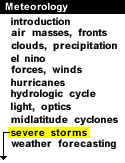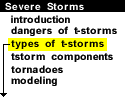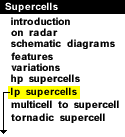
|
A westward view of the LP storm model's vertical cross-section shows the LP storm's undersized, rotating Cb and its small, nearly transparent precipitation area. Rotating cloud signatures are commonly visible in this supercell type, and wall clouds are frequently observed.

An oddity is that this bare-bones storm type occasionally fosters small funnel clouds that extend from the mid-levels of the Cb rather than from the Cb base! At times weak or even strong tornadoes develop from the vicinity of the wall cloud.
This LP storm did produce tornadoes -- two of them. The storm actually bordered between an LP and a classic supercell as it has a fairly large and intense radar echo (VIP 5), including a pendant. In this westward view, we note that the wall cloud was on the north side of the rain-free base, with spectacular rotating bands arranged much like barber pole stripes around the parent Cb.

Photograph by: Moller
This view gives us an excellent feel for the scale relationships between the rotating updraft and the tornado that occasionally develops beneath such an updraft. Remember, the radar hook echo is roughly equivalent in scale to the rotating Cb, whereas the tornado itself is much smaller.

Photograph by: Moller
The same storm is pictured looking northwest, as the tornado was lifting/weakening into a funnel cloud (extreme lower left). The storm has a spectacularly vaulted appearance adjacent to the precipitation area, which was nearly transparent. Scattered raindrops were falling in this precipitation area, along with 5 inch diameter hail! Thus, the lack of an opaque precipitation curtain does not preclude the possibility of very damaging hail.
This storm produced about 5 million dollars in hail damage in Borger, Texas, with one rain gauge that survived the hail fall showing only 1/4 of an inch of liquid rain. The tornado that we have witnessed in these photographs produced several hundred thousand dollars damage to an oil refinery, and several injuries.

characteristics |
|

Supercells |






